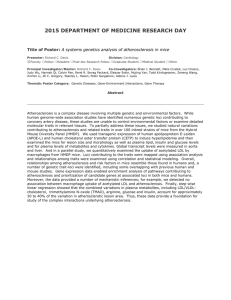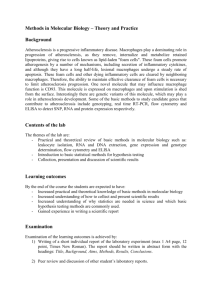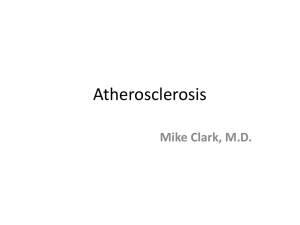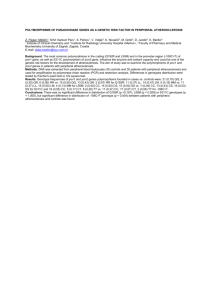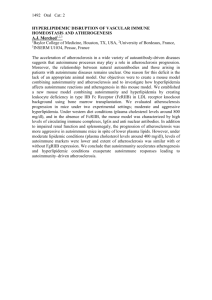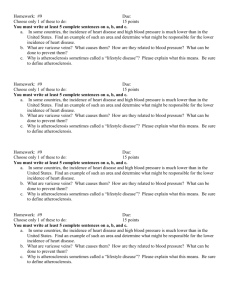If It’s Not One Thing, It’s Another: An Inverse Relationship
advertisement
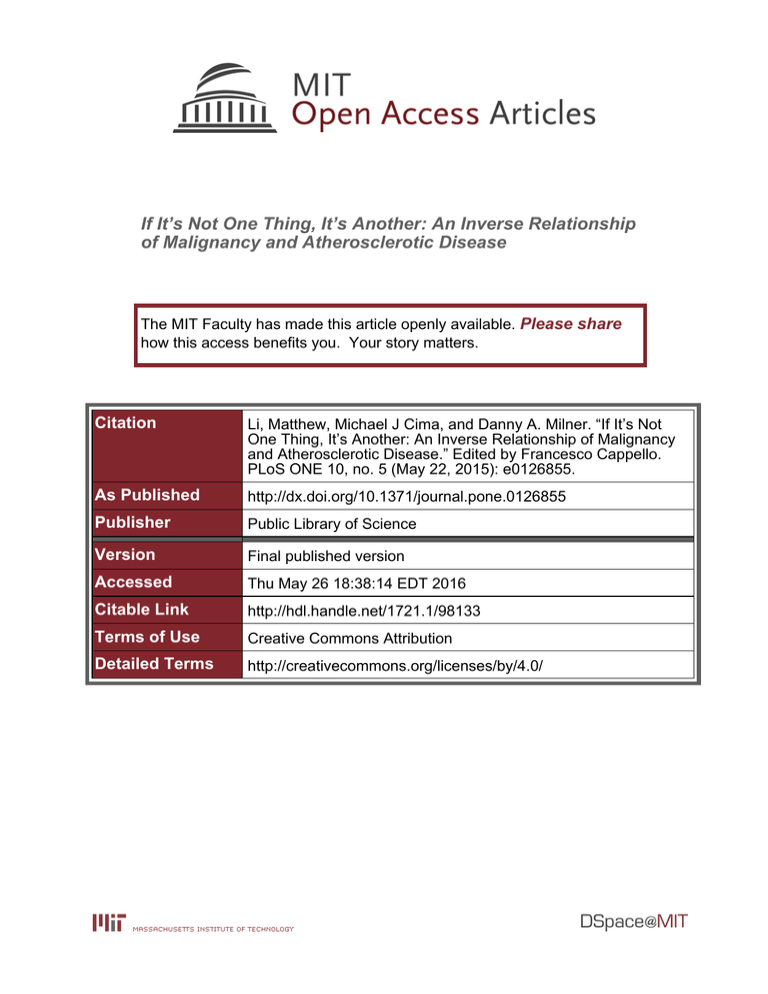
If It’s Not One Thing, It’s Another: An Inverse Relationship of Malignancy and Atherosclerotic Disease The MIT Faculty has made this article openly available. Please share how this access benefits you. Your story matters. Citation Li, Matthew, Michael J Cima, and Danny A. Milner. “If It’s Not One Thing, It’s Another: An Inverse Relationship of Malignancy and Atherosclerotic Disease.” Edited by Francesco Cappello. PLoS ONE 10, no. 5 (May 22, 2015): e0126855. As Published http://dx.doi.org/10.1371/journal.pone.0126855 Publisher Public Library of Science Version Final published version Accessed Thu May 26 18:38:14 EDT 2016 Citable Link http://hdl.handle.net/1721.1/98133 Terms of Use Creative Commons Attribution Detailed Terms http://creativecommons.org/licenses/by/4.0/ RESEARCH ARTICLE If It’s Not One Thing, It’s Another: An Inverse Relationship of Malignancy and Atherosclerotic Disease Matthew Li1*, Michael J Cima2, Danny A. Milner, Jr.3 1 Harvard-MIT Division of Health Science and Technology, Harvard Medical School, Massachusetts Institute of Technology, Cambridge, Massachusetts, United States of America, 2 Department of Materials Science and Engineering, Massachusetts Institute of Technology, Cambridge, Massachusetts, United States of America, 3 Department of Pathology, Brigham and Women’s Hospital, Boston, Massachusetts, United States of America * m_li@mit.edu Abstract OPEN ACCESS Citation: Li M, Cima MJ, Milner DA, Jr. (2015) If It’s Not One Thing, It’s Another: An Inverse Relationship of Malignancy and Atherosclerotic Disease. PLoS ONE 10(5): e0126855. doi:10.1371/journal. pone.0126855 Academic Editor: Francesco Cappello, University of Palermo, ITALY Received: February 5, 2014 Accepted: April 8, 2015 Published: May 22, 2015 Copyright: © 2015 Li et al. This is an open access article distributed under the terms of the Creative Commons Attribution License, which permits unrestricted use, distribution, and reproduction in any medium, provided the original author and source are credited. Funding: Authors DAM and ML received a SHRINE cash prize for their initial work on this dataset. Shared Health Research Information Network (SHRINE) is a network of hospital computer records for all Harvardaffiliated hospitals in the Boston area: (http://catalyst. harvard.edu/services/shrine/). The funders had no role in study design, data collection and analysis, decision to publish, or preparation of the manuscript. Competing Interests: Authors DAM and ML received a SHRINE cash prize for their initial work on this dataset. This does not alter the authors' adherence to PLOS ONE policies on sharing data and materials. Atherosclerosis and malignancy are pervasive pathological conditions that account for the bulk of morbidity and mortality in developed countries. Our current understanding of the patholobiology of these fundamental disorders suggests that inflammatory processes may differentially affect them; thus, atherosclerosis can be largely driven by inflammation, where as cancer often flourishes as inflammatory responses are modulated. A corollary of this hypothesis is that cancer (or its treatment may significantly attenuate atherosclerotic disease by diminishing host inflammatory response, suggesting potential therapeutic approaches. To evaluate the relationship between cancer and cardiovascular atherosclerotic disease, we assessed 1,024 autopsy reports from Brigham and Women’s Hospital and performed correlative analyses on atherosclerotic severity and cancer prevalence. In gender- and agematched populations, there is a statistically significant inverse correlation between history of malignancy and autopsy-proven atherosclerotic disease. In a second analysis, we evaluated 147,779 patients through analysis of the Harvard Catalyst SHRINE database and demonstrated a reduced non-coronary atherosclerotic disease rate: control (27.40%), leukemia/ lymphoma (12.57%), lung (17.63%), colorectal (18.17%), breast (9.79%), uterus/cervix (11.47%), and prostate (18.40%). We herein report that, based on two separate medical records analysis, an inverse correlation between cancer and atherosclerosis. Furthermore, this correlation is not uniformly associated with anti-neoplastic treatment, suggesting that the inverse relationship may be in part attributable to an individual’s intrinsic inflammatory propensity, and/or to inflammation-modulatory properties of neoplasms. Introduction Atherosclerosis is an inflammation driven disease characterized by arterial wall thickening associated with local hyperplastic growth and accompanied by immune cell infiltration and PLOS ONE | DOI:10.1371/journal.pone.0126855 May 22, 2015 1 / 12 Atherosclerosis vs. Cancer in Humans accumulation of lipids. Linked to events such as myocardial infarction and stroke, it is considered the causative factor for most cardiovascular diseases (CVD) and a leading candidate for worldwide mortality with roughly 13.5 million associated deaths in 2008 [1]. Several modes of interventional therapies are commonly practiced towards combating this highly pervasive disease: lifestyle changes (diet and exercise), pharmaceutical agents, and invasive vascular surgeries in the most severe cases [2]. These therapies are generally thought to be associated with improved cardiovascular risks, however, a complete understanding of their mechanisms of actions as well as inherent underlying pathological development is still lacking [3,4,5]. Recent years have demonstrated that aggressively lowering lipid levels does not have as profound an effect as once believed while the efficacious nature of statins now appears to stem from their anti-inflammatory properties; both these notions begin to challenge the long held belief that lipid control and attenuation would be the predominant path towards atherosclerotic improvement [5–11]. This has been further substantiated with the use of C-Reactive Protein (CRP), a marker of global inflammation, as a better diagnostic tool than lipid levels [12]. The World Health Organization (WHO) estimates an increase to nearly 24 million CVD associated deaths by 2030 [1]. New molecular pathways and mechanisms must be uncovered in order to recognize the critical underpinnings of atherosclerotic development and progression. Malignant cancers are considered a diverse category of diseases and encompass etiologies ranging from genetic predispositions, exposure to environmental factors, and adverse responses to inflammation. Direct associations between cancer and causative factors, such as prolonged estrogen exposure in estrogen-receptor positive breast carcinomas, exist but, unfortunately, it is not possible to state a “unifying” theory for the pathological origin of cancer. Although cancer is a leading cause of morbidity and mortality, immune surveillance provides a crucial control mechanism in keeping malignant incidences at some minimum. Hematological malignancies, including lymphomas and leukemias, are comprised of aberrant cells that normally initiate and control the inflammatory response—this may explain a greater effect in these cancers on atherosclerosis as herein reported. Immunosuppression, whether congenital, acquired, or iatrogenic, also produces malignancies in these populations more frequently than in normal hosts. We propose that the baseline human physiology can be either pro-, balanced, or anti-inflammatory; and/or that neoplastic populations also possess pan-inflammatory characteristics (more importantly, key anti-inflammatory traits). The patients may exhibit secreted factors or indirect immune modulatory processes that provide the systemic anti-inflammatory traits. As a logical extension, we suggest that atherosclerosis results, as data suggests, from pro-inflammatory individuals and, at the other end of the spectrum, anti-inflammatory individuals could have a higher predilection for cancers. This hypothesized inverse relationship between atherosclerosis and malignancy builds off of anecdotal pathological observations as well as sparse reports in literature from more than half a century ago. Several reports dating back to the 1950s noted decreased atherosclerotic burden through autopsy analyses [13,14,15]. Though this phenomenon was documented, no substantial effort was made towards establishing a concrete mechanism of action. Further, the common presumption that “chemotherapy removes atherosclerosis” is dated, unsubstantiated, and not rational within the current understanding of atherosclerotic biology. We evaluated data from Brigham and Women’s electronic medical records database and the Harvard Catalyst Shared Health Research Information Network (SHRINE) to assess the severity and prevalence of atherosclerotic disease as a function of cancer history and status. PLOS ONE | DOI:10.1371/journal.pone.0126855 May 22, 2015 2 / 12 Atherosclerosis vs. Cancer in Humans Methods Ethics statement The institutional review board of the Brigham and Women’s Hospital reviewed and approved this study. All data were analyzed either in de-identified format or were from deceased patients (over a 10 year period) in whom written informed consent was not feasible. Autopsy dataset The autopsy data set was chosen as a time point analysis for the history or current status of malignancy and definitively and completely defined atherosclerotic disease of all sites. This allowed for the assessment of two specific disease types regardless of the etiology of death. Final autopsy reports were obtained through the Brigham and Women’s Hospital Longitudinal Medical Records (BWH-LMR) database. Reports were manually analyzed from 2004–2012 for the following patient information: age, gender, history of cancer (yes/no), cancer type (if applicable), history of smoking (yes/no), hypertension (yes/no), type I/II diabetes mellitus (yes/no), aortic atherosclerosis (graded by severity), and coronary atherosclerosis (graded by severity). The qualitative reports by pathologists of atherosclerosis status in autopsy cases were normalized and assigned a numerical severity grading. The grading scale consisted of 5 tiers: none, minimal, mild, moderate, and severe. Characteristics that were commonly assessed within reports consisted of percent vessel occlusion, severity of calcification, ulcerative status, and descriptive statements of “minimal”, “severe”, etc. Exclusion criteria for reports included: only neurologic reports provided, no reported atherosclerosis status of aortic and coronaries, or patients having a history of more than one cancer. Imputation Numerous reports indicated either aortic or coronary atherosclerosis in autopsy records. Although there can be discordance between aortic and coronary atherosclerotic disease, for purposes of statistical calculations, we made an assumption that atherosclerotic disease in the aorta and coronaries likely progress on a similar time and severity scale. Unreported atherosclerosis statuses of either the coronaries or the aorta were thus imputed to prevent loss of the data point. The missing information was assigned the same grading value as the one that was actually reported. The fallacy in such imputation is regression towards the mean of effect size evaluated. The validity of this imputation was confirmed by comparing the pre- and post-imputation effects on the model outputs (S1 and S2 Tables). Medical Records Cohort Dataset Cohort information was obtained through the Harvard Catalyst Shared Health Research Information Network (SHRINE)—a web-based query tool capable of determining the aggregate number of patients at participating hospitals that meet a given set of inclusion/exclusion criteria. Our dataset was limited to a patient population over 50 years of age to avoid genetic mutations that lead to premature atherosclerotic and/or cancer syndromes. The dataset was further simplified to assess non-coronary associated atherosclerosis (cerebrovascular disease, aortic and peripheral arterial embolism or thrombosis, aortic, peripheral, and visceral artery aneurysms, and peripheral and visceral atherosclerosis). A total of 147,779 patients were available for analysis. An out-group (patients with non-pathological fractures) was selected as a proxy for “population” prevalence of atherosclerosis; this was validated against a published rate for PLOS ONE | DOI:10.1371/journal.pone.0126855 May 22, 2015 3 / 12 Atherosclerosis vs. Cancer in Humans atherosclerosis. A broad test group panel of cancers was selected: male cancer (prostate), sex independent cancer (lung and colon), female cancers (breast, uterus/cervix), and leukemia/lymphomas. Analyses were performed through dual reciprocal searches. For a given category (i.e. lymphoma), we queried the complete dataset for those with lymphoma and non-coronary associated atherosclerosis and divided by those with lymphoma only, producing a percentage. The reciprocal search was performed on those with non-coronary associated atherosclerosis with lymphoma over the total. Statistical Analysis All statistical analyses were performed through STATA Data Analysis and Statistical Software (StataCorp LP). Multivariate logistic regressions employed a jackknifing resampling technique in order to assess biases within the dataset. All regressions outputs are shown in S3 Table. The outcome variable was cancer being tested for association with aortic/coronary atherosclerosis. The covariates for the models were age, gender, history of smoking, hypertension, and diabetes. All models were initially regressed using the entirety of the aforementioned parameters. P-values for all variables and intermediate model states are shown in supporting information (S1, S2, and S3 Tables). Pseudo-r2 values for the model were computed. Model parameters were then further optimized on a per cancer subset basis as follows: the gender variable was not included in gender specific cancers; parameters were considered essential if removal resulted in a greater than 10% change in odds ratio or a greater than 5% increase in standard error. Aortic and coronary atherosclerosis were assessed in separate models. Simple imputation was used to generate missing data, for aortic and coronary, to maximize the number of valid cases in the model. Imputation proceeded as follows: when data was available for aortic but not coronary, the aortic data was assigned to coronary; when coronary data was available but not aortic, coronary data was assigned to aortic; if both were missing, the case was excluded. The natural biological correlation of aortic and coronary atherosclerosis is variable, however, only 197 cases had values imputed in either direction (19%) and 58 cases were excluded (6%). The two outputs were highly correlated and, thus, only one was used per model as to not over fit the data. Categorical analyses were performed on the following cancer groups: cancer, carcinoma, hematologic, sarcoma, neurologic, lung, breast, prostate, leukemia, lymphoma, and myeloma. Selection and subdivision into more specific cancers classes was dictated by sample number in which a minimum of n = 20 was set. Within the SHRINE data, binomial proportion was used to assess the significance of differences in the cancer groups vs. the outgroup (fractures). Results Autopsy Results Characteristics of the autopsy dataset are summarized in Table 1. A total of 1,024 final autopsy reports from Brigham and Women’s Hospital between 2004–2012 were analyzed, 502 (49.02%) were free of any cancer history while 522 (50.98%) had some history of cancer. There was a wide range of cancer subtypes, age, and prevalence of risk factors for atherosclerosis. The coronary artery disease score and the aortic atherosclerosis score showed modest agreement in the raw data set (42.39%) with Pearson correlation of 0.5864. After imputation, the agreement remained modest (53.94%) with identical correlation (0.5864). The correlation of the pre- and post-imputation scores for each category were 0.9997 (coronary artery disease) and 0.9996 (aortic atherosclerosis). In supporting information, we show the detailed OR for cancer and subtypes for both aortic and coronary atherosclerosis before and after imputation PLOS ONE | DOI:10.1371/journal.pone.0126855 May 22, 2015 4 / 12 Atherosclerosis vs. Cancer in Humans Table 1. Descriptive population statistics. Cancer No Cancer Female Male Female Male 210 312 218 284 <20 0 1 0 1 20–39 11 24 19 23 40–59 83 111 59 110 60–79 95 146 105 118 80+ 21 30 35 32 Unknown 121 180 127 171 No 55 65 41 39 Yes 34 67 50 74 No 114 151 66 88 Yes 96 161 152 196 No 185 256 148 183 Yes 25 56 70 101 # of Individuals Age Range Smoking History Hypertension Diabetes Mellitus A total of 1,024 patient files were assessed over an eight-year time frame. Information on gender, age, history of smoking, hypertension, and diabetes were assessed along side atherosclerotic burden and cancer in our multivariate analysis. doi:10.1371/journal.pone.0126855.t001 for which the ORs largely agree except as follows: Lung for aortic could not be calculated but was resulted after imputation and increased slightly for coronary; heme (grouped), neuro, and sarcoma cross 1.0 after imputation suggesting these results in a coronary model are not associated (but all held true in aortic) (S1 and S2 Tables). Significant, negative correlations were noted between presence of cancer and atherosclerosis severity when controlled for standard population characteristics and atherosclerotic risk factors. The complete cancer group had an odds ratio of 0.468 (95% CI: 0.287–0.765) for aortic atherosclerosis and 0.772 (95% CI: 0.518–1.151) for coronary atherosclerosis. Comparatively, hematologic cancers (OR 0.478, 95% CI: 0.261–0.874), carcinoma (OR 0.566, 95% CI: 0.293– 1.070), sarcoma (OR 0.561, 95% 0.112–2.799), and neurologic cancers (OR 0.301, 95% CI: 0.112–2.799) had similar effects on aortic atherosclerosis, Table 2. There appeared greater disparity in coronary atherosclerosis: hematologic (OR 1.047, 95% CI: 0.604–1.814), carcinoma (OR 0.596, 95% CI: 0.370–0.960), sarcoma (OR 0.869, 95% CI: 0.230–3.286), and neurologic (OR 1.182, 95% CI: 0.361–3.873), Table 3. Further sub-categorical analyses can be found in both Tables 2 and 3. Pseudo-r2 (ρ2) values for each model are shown in supporting information tables but ranged from 0.12 to 0.32 depending on the model (S1, S2, and S3 Tables). It should be mentioned that pseudo-r2 interpretations are quite different from standard r2 analyses. Values from 0.2–0.4 are said to have excellent fit characteristics where the ~0.15 range is fair [16]. There appears to be a heterogeneous, correlative spread between atherosclerosis severity (with variance between aortic and coronary) and specific subgroups of cancers. Though this may be resultant of underlying/associative factors aside from the cancers themselves, we believe that this is not the case, and the differences are inherently tied to the cancer types themselves. PLOS ONE | DOI:10.1371/journal.pone.0126855 May 22, 2015 5 / 12 Atherosclerosis vs. Cancer in Humans Table 2. Aortic atherosclerosis, statistical results. Odds Ratio Std Error P CI ρ2 n Cancer 0.468 0.117 0.002 0.287–0.765 0.2309 522 Carcinoma 0.566 0.184 0.080 0.293–1.070 0.2310 259 Breast 0.329 0.218 0.095 0.084–1.218 0.2840 23 Prostate* . . . . 0.2683 22 Lung 1.801 1.90 0.577 0.228–14.213 0.2585 50 Heme 0.478 0.148 0.017 0.261–0.874 0.2417 177 Leukemia 0.434 0.157 0.021 0.213–0.884 0.2417 90 Lymphoma 0.729 0.351 0.511 0.283–1.873 0.2679 65 Multiple Myloma 0.135 0.083 0.001 0.126–1.238 0.2803 22 Neuro 0.301 0.170 0.033 0.100–0.090 0.2818 25 Sarcoma 0.561 0.460 0.481 0.112–2.799 0.2624 22 A multivariate jackknife analysis method was employed using STATA Data Analysis and Statistical Software. N = 20 was the minimum number of samples set for analysis. ρ2 is known as pseudo R2. Note that the n column is not cumulative as "carcinoma" includes breast, prostate, and lung. * Logistic regression sub-analysis was prostate was not possible; likely stemming from insufficient data. doi:10.1371/journal.pone.0126855.t002 SHRINE Results Larger, multi-hospital cohort analysis revealed a significantly lower incidence of diagnosed atherosclerotic related conditions when compared to the control group (non-pathological fractures); the dataset is summarized in Table 4. This dataset was composed of a smaller subset of cancer types; these cancers were informed by our autopsy results and represented a spread between genders and the more clinically prevalent neoplasms. All prevalence rates for all cancer types when compared with the fracture group were highly significant (p-value <0.0001). Patients in the fractures control group exhibited a diagnosed, non-coronary atherosclerotic disease rate of 27.40%. This value is nearly double all cancer groups that were tested; leukemia/ lymphoma (12.57%), lung (17.63%), colorectal (18.17%), breast (9.79%), uterus/cervix (11.47%), and prostate (18.40%). Overall, there is a decreased incidence in all cancers as Table 3. Coronary atherosclerosis, statistical results. Odds Ratio Std Error P CI ρ2 n Cancer 0.772 0.157 0.204 0.518–1.151 0.1286 522 Carcinoma 0.596 0.145 0.033 0.370–0.960 0.1435 259 Breast 0.378 0.211 0.082 0.127–1.131 0.1946 23 Prostate 0.893 0.953 0.916 0.110–7.224 0.1699 22 Lung 2.165 1.639 0.307 0.491–9.544 0.1787 50 Heme 1.047 0.294 0.871 0.604–1.814 0.1586 177 Leukemia 0.763 0.259 0.425 0.392–1.483 0.2417 90 Lymphoma 3.429 1.98 0.033 1.106–10.632 0.1577 65 Multiple Myeloma 0.395 0.230 0.111 0.126–1.238 0.1886 22 Neuro 1.182 0.716 0.783 0.361–3.873 0.1869 25 Sarcoma 0.869 0.590 0.836 0.230–3.286 0.1733 22 A multivariate jackknife analysis method was employed using STATA Data Analysis and Statistical Software. N = 20 was the minimum number of samples set for analysis. ρ2 is known as pseudo R2. Note that the n column is not cumulative as "carcinoma" includes breast, prostate, and lung. doi:10.1371/journal.pone.0126855.t003 PLOS ONE | DOI:10.1371/journal.pone.0126855 May 22, 2015 6 / 12 Atherosclerosis vs. Cancer in Humans Table 4. Atherosclerotic prevalence in leukemia/lymphoma, lung, colorectal, breast, uterus/cervix, prostate cancer patients and control group: fractures; patients 50 years old. Both Subgroup Prevalence (%) Within Total Athero Prevalence (%) of Athero Within Total Subgroup Leukemia/Lymphoma 4.44 12.57 Lung 5.35 17.63 Colorectal* 5.54 18.17 Breast 5.57 9.79 Uterus/Cervix 1.41 11.47 Male Prostate 5.86 18.40 Out group Fractures 9.54 27.40 Female Prevalence (%) within total athero = (# of patients with specific cancer and athero) / (total # of patients with athero) * 100. Prevalence (%) of athero within total subgroup = (# of patient with specific cancer and athero) / (total # of patients with specific cancer) * 100. * The colorectal data from BIDMC produced a fatal error in the union set search and was, therefore, excluded. doi:10.1371/journal.pone.0126855.t004 expected based on our autopsy results, however, we once again see a disparity between the reported values that likely stem from the differences between the cancers themselves. Discussion It is apparent from our study that there exists an inverse relationship between cancer and atherosclerosis. Utilizing two sources of electronic medical records, we found that on a broad scale, patients of cancer are less likely to be clinically diagnosed for cardiovascular diseases while post-mortem analysis indicates that the severity of any present atherosclerotic disease is significantly diminished in such patients. We believe that the anti-inflammatory aspect of cancer’s pan-inflammatory response plays an important role towards atherosclerotic attenuation. Alternatively, the hypothesis of natural pro- versus anti-inflammatory physiology in an individual patient is supported by this data. The seemingly forgotten notion that aspects of cancer may possess the ability to attenuate atherosclerosis provides a unique approach towards filling this gap in our knowledge between biology, pathology, and eventually novel therapies [13,14,15]. Likely stemming from the innate complexities and non-obvious associations between cancer and atherosclerosis, there is a distinct lack of knowledge regarding their influences on one another. Arguably, there are numerous factors clouding a clear path to causality. For instance, treatment and symptoms of cancer such as chemotherapy and cachexia have demonstrated the ability to reverse atherosclerosis [17–20]. Such effects, however, are not completely straightforward; reports have shown that certain chemotherapeutics can promote atherosclerosis, while the inflammatory nature of cachexia and wasting has been shown to aggravate lesion development [21,22]. Contrasting these thoughts, we believe that the underlying mechanism lies in possibly innate variations in human physiology or the direct effect of cancer biology—rather than in the treatments or symptomatic manifestations. The correlation between coronary artery disease and atherosclerotic disease of the aorta was modest in our data set (0.5864), which reflects the known biological observation that patients may have a severe form of either with no relation to the other. Thus, patients with severe coronary artery disease leading to myocardial infarctions may have relatively clean aortic walls. To avoid loss of patients in our autopsy dataset, we imputed the aortic and coronary artery atherosclerosis scores from each other in a small number of cases. In doing so, the correlation in the data set remained the same (0.5864) and comparison of the pre- and post-imputation ORs for a given comparison showed little change except as noted above. This confirms that, despite the PLOS ONE | DOI:10.1371/journal.pone.0126855 May 22, 2015 7 / 12 Atherosclerosis vs. Cancer in Humans use of imputation, the data set we analyzed is essentially the same as the raw data set for the purposes of the associations we are comparing. Several of the results with respect to our study are likely to be explained by presently known biology. Interestingly, our SHRINE results show that the fractures out-group had an atherosclerotic rate of 27.4%, which was incidentally very similar to reported values in our selected age group; this external validation adds confidence to our findings [23]. Our SHRINE dataset showed that prostate, lung, and colon cancer demonstrated essentially equivalent rates of atherosclerosis, 17.6–18.4%, which are less than fractures. We suspect that our anti-inflammatory hypothesis plays a role in these patients. We see that in our autopsy analysis, however, lung cancer has significantly elevated odds ratios, 1.801 in aortic and 2.165 in coronary atherosclerosis. We note the following may lead to the witnessed discrepancies and increased rate of atherosclerosis: a) lung cancer is strongly associated with smoking which aggravates atherosclerosis, b) instances of colon cancer are linked with a high fat diet which is also known to accentuate atherosclerosis [24,25]. Prostate cancer does not exhibit as pronounced an effect on atherosclerosis as other cancers. This may be due to that fact that prostate cancer is typically a disease of age and will thus have more overlap with similar temporally related diseases such as atherosclerosis. It should also be noted that our model could not produce an odds ratio association in our sub-analysis for aortic atherosclerosis due to low sample numbers. A larger sample set for this specific cancer is needed to address this issue. We confirmed that the inability to produce an odds ratio value was not due to co-linearity. Regression analysis between aortic atherosclerosis and prostate cancer values produced an R2 value of 0.01. A reduced incidence of atherosclerotic disease and severity in breast and uterine/cervical cancer, seen in both autopsy and SHRINE analyses, comes as little surprise. Estrogen is known to be protective of atherosclerosis [26,27]. Estrogen likely explains the lower incidences of cardiovascular disease in women versus men. Cancers of the breast and uterus/cervix may result in an increased production of cellular derived estrogen resulting in an anti-atherosclerotic environment. Results from the hematologic neoplasms proved to be the most unexpected and interesting. Autopsy analysis revealed odds ratios for aortic and coronary atherosclerosis of 0.434, 0.729, 0.135 and 0.763, 3.429, and 0.395 for leukemias, lymphomas, and multiple myeloma respectively. SHRINE data showed an incidence rate or 12.6%, which is less than prostate and sex-independent cancers and at a similar rate compared to female cancers. There has yet to be a fully substantiated mechanism of action proposed for this phenomenon. We hypothesize that, due to cellular nature of these hematopoietic malignancies, an antiinflammatory environment is promoted or perhaps existed in these patient’s baseline physiology, inherently leading to the reduction of any present atherosclerotic burden. What is unclear about this notion is whether released cytokines directly affect plaques or whether an indirect immune-modulation relationship is established eventually leading to an anti-atherosclerotic environment. For instance, it has been shown that regulatory T-cells are prevalent in acute myelogenous leukemia (AML) as a means for immune surveillance evasion [28]. It has also been demonstrated that regulatory T cells posses the ability to attenuate atherosclerosis [29, 30]. Thus, the increased regulatory T-cell recruitment may be one mechanism by which an anti-inflammatory physiology is obtained. A rapidly expanding field, cancer immunology may provide illuminating insight into the herein reported phenomenon. A hallmark feature of cancer is its ability to evade the host immune system. This allows for unabated tumor expansion and increased potential for metastasis. It is reported that cancer is able to accomplish this feat through numerous mechanisms: downregulation of surface antigen presenting proteins, cytokine secretion, and reorganization PLOS ONE | DOI:10.1371/journal.pone.0126855 May 22, 2015 8 / 12 Atherosclerosis vs. Cancer in Humans of the local stromal environment. The predominant mechanism of action is thought to be resultant from cytokine production [31]. These cytokines are suggested to have broad reaching, immune-modulatory effects that have implications in atherogenesis. TGF-β and IL-10, for example, are two pleiotropic factors released by numerous cancers that have generalized anti-inflammatory properties. These two factors can act as T-cell and macrophage suppressors (cells able to eliminate cancer) while also promoting the development of regulatory T-cells (cells able to prevent tumor specific immune responses), as mentioned previously. There is concordant evidence that shifts in these particular immune populations are able to control atherosclerotic lesion development [28–34]. It should also be noted that cancer cells are well known to secrete pro-inflammatory cytokines such as TNF-α, IL-6, and IL-1β; all of which act to promote a local, pro-neoplastic environment (which may also influence atherosclerosis) [35]. It is still unknown whether these are the actual mechanism by which cancer is capable of modulating atherosclerosis, however, the pro/anti-inflammatory balance and immunological linkages between these two disease speaks to the feasibility of the notion. Further studies have demonstrated that secreted factors from primary tumors and cancer cell lines are able to regulate T-cell associated inflammation. Several distinct cancer types interfere with NF-κB signaling, prompting anti-inflammatory activity. One study demonstrated that supernatant derived from AML cells inhibit T-cell nuclear translocation of NF-κB with associated reductions in IL-2 and IFN-y production [36]. A similar reduction in NF-κB translocation was seen in renal cell carcinomas [37]. NF-κB is a known regulator of atherosclerotic cytokines such as IL-6, TNF-α, and IL-1β. Thus, NF-κB modification may be a potential mechanism by which lesion attenuation is achieved via a diminishment in pro-atherosclerotic cytokines. It would be of interested to investigate whether similar effects were achieved in other prominent cells found in atherosclerotic lesions such as monocytes and macrophages. There were several issues with respect to our study that we were unable to fully resolve. One such factor was the temporal component of patients’ cancer burdens; this is clearly an issue experienced by the clinical cancer field as a whole. Our hypothesis revolves around the notion that cancer arises from and promotes a global anti-inflammatory physiology. We postulate that those with longer courses of cancer burden are likely to have an extensive molecular, anti-inflammatory signature with associated reduced atherosclerotic burden compared to those with shorter cancer courses. Presently, determining the exact timeframe of cancer in humans is not possible on a clinical scale. Any further experimentation on this phenomenon will likely be most fruitful in vivo where cancer induction and tracking can be rigorously controlled and monitored. Another clinical aspect we were unable to fully resolve was chemotherapy. We did not exclude/include patients based on surgical cure, presence/absence of chemotherapy, or palliative care only status. Thus, our sampling represents the full spectrum of whatever effect chemotherapy may have on atherosclerosis. With the numerous forms of chemotherapy compounded with various treatment durations, inclusion and analysis proved to be intangible. Given that such treatments are historically aimed towards rapidly dividing cells, unlike resident atherosclerotic foam cells, it does not seem likely that diminished atherosclerosis rates in this study in the timescale of treatment for cancer is due to chemotherapeutics. Furthermore, reversibility in the dynamics of atherosclerotic disease occurs in early lesions and at the coronary level but has not been demonstrated in large complex plaque lesions [38–40]. The discrepancies between aortic and coronary atherosclerosis also presented an interesting result. The locational differences clearly result in drastic pathology spanning myocardial infarction to stroke. Although the effect of soluble cancer factors may systemic, such observed differences may be due to the underlying variations in hemodynamics. Because the autopsy data was PLOS ONE | DOI:10.1371/journal.pone.0126855 May 22, 2015 9 / 12 Atherosclerosis vs. Cancer in Humans incomplete and, thus, imputation was used for statistical purposes, we cannot fully evaluate the specific relationships between coronary or aortic atherosclerosis independently in our data set. The herein results represents one of the only recent reports that addresses the inverse relationship between cancer and atherosclerosis. More exhaustive studies are clearly necessary in order to truly understand the mechanisms behind this phenomenon. We believe that this novel paradigm will uncover novel biology towards a greater understanding, and eventually treatment, of atherosclerotic disease. Supporting Information S1 Table. The primary outputs are shown for all cancers in the multivariate models including aortic or coronary are shown for non-imputed (raw) data by each diagnosis type with a corresponding optimized model (where non-selected co-variates are removed). (XLSX) S2 Table. The primary outputs are shown for all cancers in the multivariate models including aortic or coronary are shown for imputed data by each diagnosis type with a corresponding optimized model (where non-selected co-variates are removed). (XLSX) S3 Table. The summarized odds ratios are shown of all models (output = cancer type) for non-imputed and imputed data for aortic and coronary disease. (XLSX) Acknowledgments We wish to thank the Harvard Catalyst Program for providing us with the opportunity to utilized the SHRINE database as well as Partners Healthcare for access to the Research Patient Data Registry to complete this work. Author Contributions Conceived and designed the experiments: ML DAM. Performed the experiments: ML DAM. Analyzed the data: ML DAM MJC. Contributed reagents/materials/analysis tools: ML DAM. Wrote the paper: ML DAM MJC. References 1. World Health Organization, Cardiovascular disease (CVDs), http://www.who.int/mediacentre/ factsheets/fs317/en/index.html. 2. Mayo Clinic, Heart Disease: Treatments and drugs, http://www.mayoclinic.com/health/heart-disease/ DS01120/DSECTION=treatments-and-drugs. 3. Scandinavian Simvastatin Survival Study Group, Randomised trial of cholesterol lowering in 4444 patients with coronary heart disease: the Scandinavian Simvastatin Survival Study (4S), The Lancet, 344:1383–89 (1994). PMID: 7968073 4. Cholesterol Treatment Trialists’ (CTT) Collaborators, Efficacy and safety of cholesterol-lowering treatment: prospective meta-analysis of data from 90 056 participants in 14 randomised trials of statins. The Lancet, 366:1267–78 (2005). PMID: 16214597 5. Steinberg D, Thematic review series: The Pathogenesis of Atherosclerosis. An interpretive history of the cholesterol controversy: part I, The Journal of Lipid Research, 45:1583–1593 (2004). PMID: 15102877 6. Forrester JS, Bairey-Merz CN, Kaul S, The aggressive low density lipoprotein lowering controversy, Journal of the American College of Cardiology, 36(4):1419–1425 (2000). PMID: 11028504 PLOS ONE | DOI:10.1371/journal.pone.0126855 May 22, 2015 10 / 12 Atherosclerosis vs. Cancer in Humans 7. Hayward RA, Hofer TP, Vijan S, Narrative review: lack of evidence for recommended low-density lipoprotein treatment targets: a solvable problem, Ann Intern Med, 145(7):520–30 (2006). PMID: 17015870 8. Jain MK, Ridker PM, Anti-Inflammatory Effects of Statins: Clinical Evidence and Basic Mechanisms, Nature Reviews Drug Discovery, 4:977–987 (2005). PMID: 16341063 9. Yaakov Henkin, Re-Evaluating Therapeutic Target Goals for Statin-Treated Patients, Journal of the American College of Cardiology, 52(8) (2008). doi: 10.1016/j.jacc.2008.05.002 PMID: 18702977 10. Weitz-Schmidt G, Statins as anti-inflammatory agents, Trends in ParmacologicalSceinces, 23 (10):482–487 (2002). PMID: 12368073 11. Sparrow CP, Burton CA, Hernandez M, Mundt S, Hassing H, Patel S, et al. . ., Simvastatin Has Anti-Inflammatory and Antiatherosclerotic Activities Independent of Plasma Cholesterol Lowering, Arteriosclerosis, Thrombosis, and Vascular Biology, 23:115–121 (2001). 12. Ridker PM, Rifai N, Rose L, Buring JE, Cook NR, Comparison of C-Reactive Protein and Low-Density Lipoprotein Cholesterol Levels in Prediction of First Cardiovascular Events, The New England Journal of Medicine, 347:1557–1565 (2002). PMID: 12432042 13. Elkeles A, Cancer and Atherosclerosis, British Journal of Cancer, 10(2):247–250 (1956). PMID: 13364114 14. Elkeles A, Calcified Atherosclerosis and Cancer, British Journal of Cancer, 13(3):403–407 (1959). 15. Winklestein R, Lilienfeld R Jr., Pickren JW, Lilienfeld AM, The Relationship Between Aortic Atherosclerosis and Cancer, British Journal of Cancer, 13(4):606–613. 16. McFadden D, Quantitative methods for analyzing travel behavior of individuals: Some recent developments, Cowles Foundation discussion paper no. 474, Yale University, New Haven, CT (1977). 17. Spain DM, Greenblatt IJ, Snapper I, Cohn T, The degree of coronary and aortic atherosclerosis in necropsied cases of multiple myeloma, The American Journal of Medical Sciences, 231(2):165–7 (1956). PMID: 13282898 18. Numano F, Chemotherapy of atherosclerosis, Japan Circulation Journal, 44(1):55–68 (1980). PMID: 6245288 19. Maniscalco BS, Taylor KA, Calcification in coronary artery disease can be reversed by EDTA-tetracycline long-term chemotherapy, Pathophysiology, 11(2):95–101 (2004). PMID: 15364120 20. Wilens SL, The resorption of arterial atheromatous deposits in wasting disease, American Journal of Pathology, 23(5):793–804 (1947). PMID: 19970960 21. Skeijima T, Tanabe A, Maruoka R, Fijishiro N, Yu S, Fujiwara S, et al, Impact of platinum-based chemotherapy on the progression of atherosclerosis, Climacteric, 14(1):31–40 (2011). doi: 10.3109/ 13697137.2010.522278 PMID: 21067421 22. Zyga S, Christopoulou G, Malliarou M, Malnutrition-Inflammation-Atherosclerosis Syndrome in Patients With End-Stage Renal Disease, Journal of Renal Care, 37(1):12–15 (2011). doi: 10.1111/j.1755-6686. 2011.00201.x PMID: 21288312 23. Jaffer FA, O’Donnell CJ, Larson MG, Chan SK, Kissinger KV, Kupka MJ, et al, Age and Sex Distribution of Subclinical Aortic Atherosclerosis: A Magnetic Resonance Imaging Examination of the Framingham Heart Study, Arteriosclerosis, Thrombosis, and Vascular Biology, 22:849–854 (2002). PMID: 12006401 24. Howard G, Wagenknecht LE, Burke GL, Diez-Roux A, Evans GW, McGovern P, et al. GS,Cigarette Smoking and Progression of Atherosclerosis. The Journal of the American Medical Association, 308 (24):2577–2583 (1998). 25. Slattery ML, Boucher KM, Caan BJ, Potter JD, Ma KN,Eating Patterns and Risk of Colon Cancer. American Journal of Epidemiology, 148(1):4–16 (1998). PMID: 9663397 26. Marsh MM, Walker VR, Curtiss LK, Banka CL,Protection against atherosclerosis by estrogen is independent of plasma cholesterol levels in LDL receptor-deficient mice. Journal of Lipid Research, 40:893–900 (1999). PMID: 10224158 27. Nathan L, Chaudhuri G, Estrogens and Atherosclerosis, Annual Reviews Pharmacology and Toxicology, 37:477–515 (1997). PMID: 9131262 28. Ustun G, Miller JS, Munn DH, Weisdorf DJ, Blazar BR, Regulatory T cells in acute myelogenous leukemia: is it time for immunomodulation?,Blood, 118(19):5084–5095 (2011). doi: 10.1182/blood-2011-07365817 PMID: 21881045 29. Mallat Z, Ait-Oufella H, Tedgui A, Regulatory T-Cell Immunity in Atherosclerosis, Trends in Cardiovascular Medicine, 17(4):113–118 (2007). PMID: 17482092 PLOS ONE | DOI:10.1371/journal.pone.0126855 May 22, 2015 11 / 12 Atherosclerosis vs. Cancer in Humans 30. Ait-Oufella H, Salomon BL, Potteaux S, Robertson AKL, Gourdy P, Zoll J, et al, Natural regulatory T cells control the development of atherosclerosis in mice, Nature Medicine, 12,178–180 (2006). PMID: 16462800 31. Zindl CL, Chaplin DD, Tumor Immune Evasion, Science, 329(5979):697–698 (2010). doi: 10.1126/ science.1190310 PMID: 20448171 32. Topfer K, Kempe S, Muller N, Schmitz M, Bachmann M, Cartellieri M, et al, Tumor Evasion from T Cell Surveillance, Journal of Biomedicine and Biotechnology, (2011). 33. Ammirati E, Cianflone D, Vecchio V, Banfi M, Vermi A, De Metrio M, Grigore L, et al, Effector Memory T cells Are Associated With Atherosclerosis in Humans and Animal Models, Journal of the American Heart Association, 1:27–41 (2012). doi: 10.1161/JAHA.111.000125 PMID: 23130116 34. Mallat Z, Besnard S, Duriez M, Deleuze V, Emmanuel F, Bureau MF, Soubrier F, et al, Protective role of interleukin-10 in atherosclerosis, Circulation Research, 15; 85(8):e17–24 (1999). PMID: 10521249 35. Coussens LM, Werb Z, Inflammation and cancer, Nature, 420:860–867 (2002). PMID: 12490959 36. Buggins GS, Milojkovic D, Arno MJ, Lea NC, Mufti GJ, Thomas NSB, et al. Microenvironment Produced by Acute Myeloid Leukemia Cells Prevents T Cell Activation and Proliferation by Inhibition of Nf-kB, cMyc, and pRb Pathways, The Journal of Immunology, 167: 6021–6030 (2001). PMID: 11698483 37. Kim HJ, Park JK, Kim YG, Suppression of NF-kB Activation in Normal T Cells by Supernatant Fluid from Human Renal Cell Carcinomas, Journal of Korean Medical Science, 14:299–303 (1998). 38. Poli A, Corsini A. Reversible and non-reversible cardiovascular risk in patients treated with lipid-lowering therapy: analysis of SEAS and JUPITER trials. Eur J Intern Med. 2010 Oct; 21(5):372–3. doi: 10. 1016/j.ejim.2010.04.013 Epub 2010 Jul 3. PMID: 20816586 39. Oka K, Chan L. Inhibition and regression of atherosclerotic lesions. Acta Biochim Pol. 2005; 52(2):311– 9. Epub 2005 Jun 3. PMID: 15940346 40. Sacks FM, Gibson CM, Rosner B, Pasternak RC, Stone PH. The influence of pretreatment low density lipoprotein cholesterol concentrations on the effect of hypocholesterolemic therapy on coronary atherosclerosis in angiographic trials. Harvard Atherosclerosis Reversibility Project Research Group. Am J Cardiol. 1995 Sep 28; 76(9):78C–85C. PMID: 7572692 PLOS ONE | DOI:10.1371/journal.pone.0126855 May 22, 2015 12 / 12


